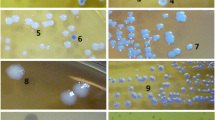Abstract
Three methods—the most probable number technique, a cellulose agar overlay on basal carbohydrate plates, and carboxymethylcellulose in basal carbohydrate plates—were compared for ease of preparation, interpretation of results, and agreement in estimation of size of the cellulolytic bacterial population in digesta samples from the rumen. The most probable number method yielded consistent detection of cellulose hydrolysis in liquid medium but required at least a 10-day incubation, and its mean was associated with wide 95% confidence intervals. The cellulose overlay method was the least consistent, and zones of hydrolysis often were difficult to see. The carboxymethylcellulose method was the easiest method for preparation and required only a 2-day incubation. The three methods estimated the same population size (all within one-half log unit of each other), but the carboxymethylcellulose method had the lowest coefficient of variation.
Similar content being viewed by others
Literature Cited
Balch WE, Fox GE, Magrum LJ, Woese CR, Wolfe RS (1979) Methanogens: reevaluation of a unique biological group. Microbiol Rev 43:260–296
Bryant MP (1972) Commentary on the Hungate technique for culture of anaerobic bacteria. Am J Clin Nutr 25:1324–1329
Bryant MP, Burkey LA (1953) Cultural methods and some characteristics of some of the more numerous groups of bacteria in the bovine rumen. J Dairy Sci 36:205–217
Clarke KR, Owens NJP (1983) A simple and versatile microcomputer program for the determination of “most probable number”. J Microbiol Methods 1:133–137
Cochran WG (1950) Estimation of bacterial densities by means of the “Most Probable Number.” Biometrics 6:105–116
Hungate RE (1950) The anaerobic mesophilic cellulolytic bacteria. Bacteriol Rev 14:1–49
Hungate RE (1966) The rumen and Its microbes. New York: Academic Press
Leedle JAZ, Bryant MP, Hespell RB (1982) Diurnal variations in bacterial numbers and fluid parameters in ruminal contents of animals fed low-and high-forage diets. Appl Environ Microbiol 44:402–412
Leedle JAZ, Hespell RB (1980) Differential carbohydrate media and anaerobic replica plating technques in delineating carbohydrate-utilizing subgroups in rumen bacterial populations. Appl Environ Microbiol 39:709–719
SAS (1982) SAS user's guide: basics. Cary NC: Statistica Analysis System Institute
Snedecor GW, Cochran WG (1980) Statistical methods. Ames IA: Iowa State University Press
Teather RM, Wood PJ (1982) Use of Congo red-polysaccharide interactions in enumeration and characterization of cellulolytic bacteria from the bovine rumen. Appl Environ Microbiol 43:777–780
VanGylswk NO, Schwartz HM (1984) Microbial ecology and cellulose and hemicellulose metabolism in gastrointestinal ecosystems. In: Klug MJ, Reddy CA (eds) Current perspectives in microbial ecology: proceedings of the third international symposium on microbial ecology. Washington DC: American Society for Microbiology, pp 588–599
Author information
Authors and Affiliations
Rights and permissions
About this article
Cite this article
Leedle, J.A.Z., Butine, T.J. Enumeration of cellulolytic anaerobic bacteria from the bovine rumen: Comparison of three methods. Current Microbiology 15, 77–79 (1987). https://doi.org/10.1007/BF01589365
Issue Date:
DOI: https://doi.org/10.1007/BF01589365




